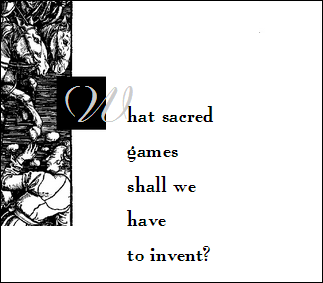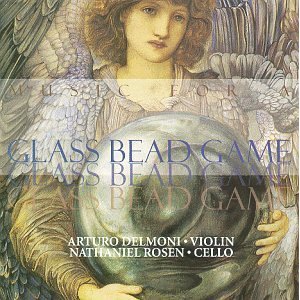Hipbone/Sembl: psychological perspectives
[ a Jungian view, Hipbone/Sembl and the feminine, also an early use of the games in dream-analysis online ]
 I just received an email from Eve Jackson, an old friend of mine, Jungian analyst and Buddhist practitioner, who has recently been exploring my HipBone Games and expressed her interest in their web-based development as Sembl. One paragraph in particular stood out for me, since it speaks to the issue of the feminine in the games — something I am reluctant to do myself — and also because it emphasizes a central interest and hope of mine, the possible significance of the games in conflict resolution and its expression at the global level of the diversity of cultures:
I just received an email from Eve Jackson, an old friend of mine, Jungian analyst and Buddhist practitioner, who has recently been exploring my HipBone Games and expressed her interest in their web-based development as Sembl. One paragraph in particular stood out for me, since it speaks to the issue of the feminine in the games — something I am reluctant to do myself — and also because it emphasizes a central interest and hope of mine, the possible significance of the games in conflict resolution and its expression at the global level of the diversity of cultures:
Also pleased to read about your friend Cath’s museum game and, especially, the possibility of using the games for conflict resolution. I see the whole thing as having to do with feminine consciousness, which is much needed. Jung emphasises differentiation and the hero archetype in the development of consciousness, hence it tends to be seen by Jungians as a masculine phenomenon, arising from a feminine background of fusion. But consciousness also develops by seeing likeness. Also Jung still lived in a world where one could (and he felt should) work within ones own geographically limited tradition. Now so many strands that had been separated need to be creatively reconnected so the whole complexity can be glimpsed, it can’t be avoided.
I’m very grateful for those words, which express succinctly some of my own key hopes for the game…
Here are the relevant paragraphs of her email in full — personal in part, because each person’s own playing of the game will naturally draw on their own store of images, narratives, quotations etc, but also of that wide significance of which Anais Nin wrote, “The personal, if it is deep enough, becomes universal, mythic, symbolic.” In these paragraphs you will find the personal touching the mythic, and thus giving voice to the universal:
I have been experimenting with your games, drawn back to them by cunning paths of association, and passing the link on to a few likely people. Always remembered the stuff you sent me years ago about Oppenheimer and the Gita which deeply impressed me but got sidelined by the demands of life. Perhaps I feared that such things could be addictive – have always shied away from chess, poker, bridge because I could see them keeping me awake at night.
Now I find myself pleasantly caught. Even got a copy of the Bead Game to reread. Frankly I prefer the hipbone games as less abstract and cerebral than the version Hesse implies, and because there’s a sense in which the Hesse game involves too much labour of consciousness, and even though it can induce satori it risks dryness, lacking the spontaneity/immediacy of hipbone, so that Castalia becomes a sort of severed head. Hesse was clearly aware of this problem himself, hence the relief of Knecht returning to the more natural world, which experience, alas, he can’t sustain. But hipbone is moister, more democratic and more genuinely playful as the unconscious has more free rein. Into my current life in Crete, living with great beauty and blessings in the agony of a disintegrating world, with many levels of occupation and preoccupation, your game has entered as a vivifying current.
Knocked out (not of course for the first time) by the play of the mind, how what is dimly remembered brings with it so much more. For example I moved from the bells of Aberdovey (sound of a drowned world) via Phlebas the Phoenician to Ariel’s song, and was astounded to discover that the song ends with bells. And that Donne’s tolling bell (a further association) follows an image of a clod disintegrating in the sea. And that the bells of Aberdovey are actually alarm bells (waking us from the solutio of sleep). And so on inevitably through the cycle of death and rebirth. These first images also reflect the process itself, the ringing of the Welsh song in my head evoking the underwater world of free-floating associations.
Also pleased to read about your friend Cath’s museum game and, especially, the possibility of using the games for conflict resolution. I see the whole thing as having to do with feminine consciousness, which is much needed. Jung emphasises differentiation and the hero archetype in the development of consciousness, hence it tends to be seen by Jungians as a masculine phenomenon, arising from a feminine background of fusion. But consciousness also develops by seeing likeness. Also Jung still lived in a world where one could (and he felt should) work within ones own geographically limited tradition. Now so many strands that had been separated need to be creatively reconnected so the whole complexity can be glimpsed, it can’t be avoided.
The Game relating to Oppenheimer and the Gita, to which my friend refers, is the solo game titled (after Nietzsche) What sacred games shall we have to invent? downloadable without cost from the Scribd site.
Those paragraphs describe a single human’s use of the Hipbone/Sembl game structure for personal exploration and insight, but this seems the appropriate place to mention that the games have also been used in therapeutic dream analysis. My friend Walter Logeman is a psychotherapist trained in Joseph Moreno’s Psychodrama techniques.
 The “Dream Events” themselves were conducted under conditions of therapeutic privacy, but Walter’s article DreamEvents in Psyberspace, written for the International Association for the Study of Dreams‘s journal, Dream Time, can give readers a detailed sense of how the games actually work in the context of dream symbolism and therapeutic amplification without breaching that temenos.
The “Dream Events” themselves were conducted under conditions of therapeutic privacy, but Walter’s article DreamEvents in Psyberspace, written for the International Association for the Study of Dreams‘s journal, Dream Time, can give readers a detailed sense of how the games actually work in the context of dream symbolism and therapeutic amplification without breaching that temenos.
In introducing Walter’s piece, guest editor Richard Wilkerson raised a question which gets to the heart of the therapeutic possibilities of the games:
How deep can relationships get in an online dream group? Walter Logeman, in DreamEvents in Psyberspace gives sample from a “game” that is played by adults online and creates for several weeks a closed and confidential setting. The game is based on Herman Hesse’s The Bead Game and allows players to make relational moves on a virtual board, connecting dreams, thoughts and feelings in a soulful way.
For myself, the answer to that question is profoundly personal and deeply moving. Stuart, one of the players in the first “Dream Event” which I co-facilitated with Walter Logeman, knew he was in the terminal stages of cancer as he dreamed and discussed and played with us, and at one point he told us how the game felt to him:
I have been thinking about why I am so drawn to what is happening here. It seems to be that this might be a game that consciousness can play with itself irrespective of its containment in a body. A propos pour moi a ce moment
I don’t know that I have ever felt so deeply moved, honored, abashed or humbled by a comment someone else has made about a work I was involved with — but Stuart wrote those words, and I think they reflect pretty accurately just how moving the “Dream Event” indeed was for those who participated.
The HipBone/Sembl games can be played for sheer fun, in friendly rivalry, in formal or informal education, solo or in collaboration, for problem solving, for insight, as meditations or works of art, to facilitate the therapeutic understanding of the self and others, in the analysis of complex, multi-stakeholder and multi-disciplinary situations, and in conflict resolution…
I am very hopeful that Cath’s work on the funding and development of the Sembl games will soon bring us a free, open source, web based version of Sembl — not just for my own delight, but also and particularly for the sake of those others who, like Stuart, can find in these games a profound depth of insight and healing.

